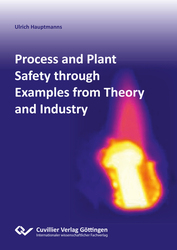| Areas | |
|---|---|
| Serie de libros (96) |
1377
|
| Nachhaltigkeit |
3
|
| Gesundheitswesen |
1
|
| Letra |
2361
|
| Ciencias Naturales |
5403
|
| Matemática | 229 |
| Informática | 318 |
| Física | 979 |
| Química | 1362 |
| Geociencias | 131 |
| Medicina humana | 243 |
| Estomatología | 10 |
| Veterinaria | 108 |
| Farmacia | 147 |
| Biología | 835 |
| Bioquímica, biología molecular, tecnología genética | 121 |
| Biofísica | 25 |
| Nutrición | 45 |
| Agricultura | 1004 |
| Silvicultura | 201 |
| Horticultura | 20 |
| Ecología y conservación de la tierra | 148 |
| Ciencias Ingeniería |
1788
|
| General |
97
|
|
Leitlinien Unfallchirurgie
5. Auflage bestellen |
|
Erweiterte Suche
Process and Plant Safety through Examples from Theory and Industry (Tienda española)
Ulrich Hauptmanns (Autor)Previo
Lectura de prueba, PDF (250 KB)
Indice, PDF (150 KB)
The present collection of calculation examples is based on the author’s experience in
teaching and his subsequent activity as a consultant to industry. It combines theoretical
questions with practical problems, which arise, for example, when preparing safety
reports or determining appropriate safety distances.
Emphasis was placed on choosing the examples such that they can be solved with simple
resources. This does not mean a rejection of computer programs but results from the
conviction that a better understanding of the context is promoted by following the
individual steps of the calculations. This understanding is a prerequisite for the
appropriate use of computer codes, which is often indispensable. The only exception is
the program for treating atmospheric dispersion of the VDI that is generally used. It
provides several results for problems dealing with appropriate safety distances.
Although all the sections start with a short introduction to the material presented, this
collection does not replace the use of textbooks and original papers.
The following areas are addressed:
• Hazardous properties of materials
• Exothermic and pressure-generating reactions
• Safe design and operation of industrial plants
• Occupational safety
• Process control
• Protection of equipment
• Event tree analysis
• Fault tree and Marcov analyses
• Consequences of accidents
• Functional safety
• Appropriate safety distances
The results are presented with numerous digits behind the decimal point solely in order
to facilitate their reproduction. Existing modelling and data uncertainties mostly warrant
the indication of just one digit behind the decimal point. They are apart from the
stochastic behaviour of parameters the justification for employing safety factors and
pessimistic assessments.
| ISBN-13 (Impresion) | 9783689527723 |
| ISBN-13 (E-Book) | 9783689527730 |
| Formato | A5 |
| Idioma | Inglés |
| Numero de paginas | 362 |
| Laminacion de la cubierta | mate |
| Edicion | 1. |
| Lugar de publicacion | Göttingen |
| Fecha de publicacion | 05.03.2025 |
| Clasificacion simple | Libro de divulgacion |
| Area |
Ciencias Naturales
Física |
| Palabras claves | Stoffeigenschaften, Entzündbarkeit, Empirische Häufigkeit, Explosionsgrenzen, Ethyl, Stadtgas, Explosionsvermeidung, Wasserstoff, Methan, Ethanol, Benzol, Adiabat, Flammentemperatur, Explosionen, Deflagration, Druckanstiegsgeschwindigkeit, Staubexplosion, Detonation, Panzerabwehrrakete, Bombe, Explosionsprodukt, Gasförmig, Material properties, Flammability, Empirical frequency, Explosion limits, ethyl, town gas, Explosion prevention, Hydrogen, methane, ethanol, benzene, Adiabatic, Flame temperature, explosions, Deflagration, Rate of pressure rise, Dust explosion, detonation, Anti-tank missile, bomb, Explosion product, Probitbeziehungen, Fluorwasserstoff, Todeswahrscheinlichkeiten, Todeswahrscheinlichkeit, Exotherm, Druckaufbauend, Exotherme Reaktion, Druckaufbauende Reaktion, Adiabate Temperaturerhöhung, chemischer Reaktor, Endtemperatur, Kühlungsausfall, Reaktionszeit, Kühlungsausfall, Reaktorkühlung, Semenov, Reaktionsgeschwindigkeit, Maximale Reaktionsgeschwindigkeit, Autokatalytische Reaktion, Inhärente Sicherheit, Nitroglykol, Herstellung Nitroglykol, Blausäure, Acrylnitril, Herstellung Acrylnitril, Festigkeitsaspekte, Betriebstemperatur, Ausgangsdruck, Exothermic, Pressurizing, Exothermic reaction, Pressurizing reaction, Adiabatic temperature increase, Chemical reactor, Final temperature, Cooling failure, reaction time, Cooling failure, Reactor cooling, Reaction speed, Maximum reaction rate, Autocatalytic reaction, Inherent safety, Nitroglycol, Production of nitroglycol, Hydrogen cyanide, Acrylonitrile, Production of acrylonitrile, Strength aspects, Operating temperature, Outlet pressure |








